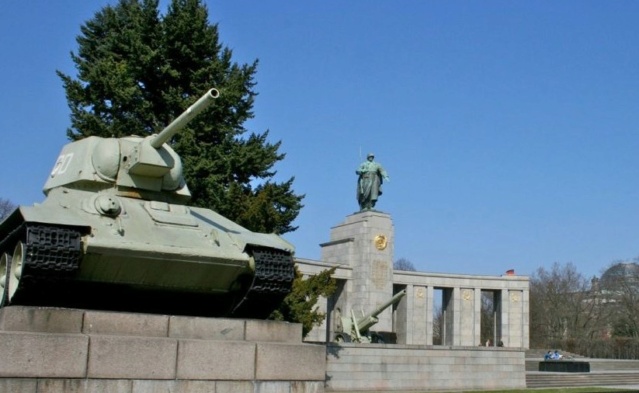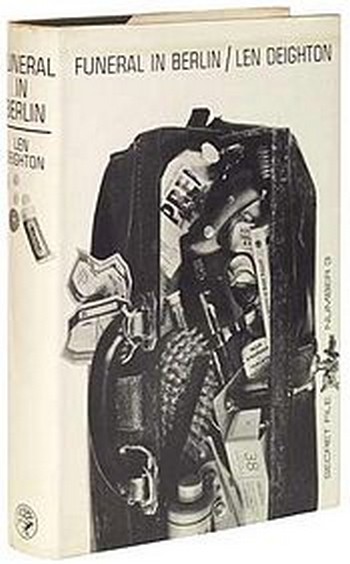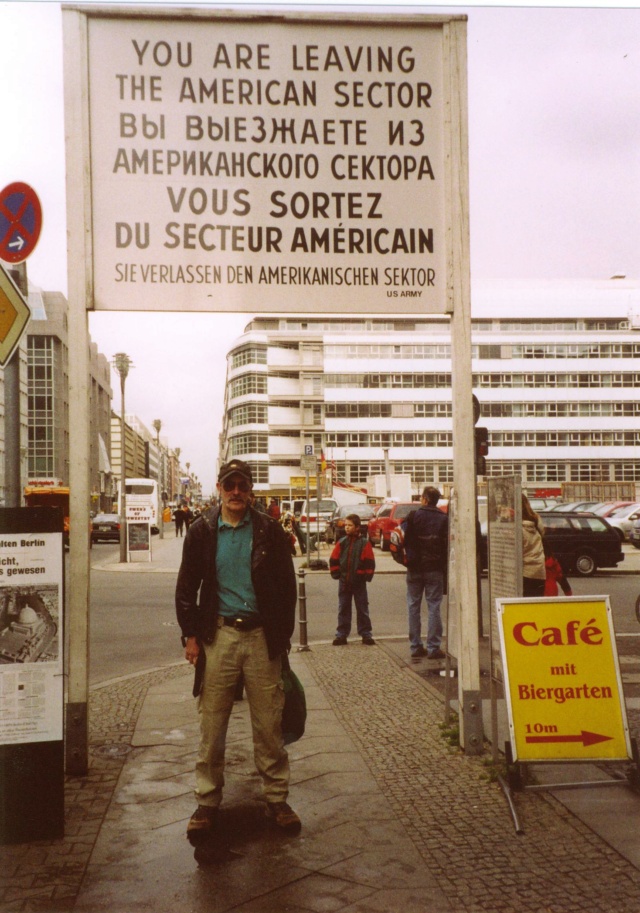Berlin was fascinating to me from an early age, as I read a great deal of military history, and espionage books. However, although I have visited Germany numerous times, and actually went to school in Cologne for a while, it wasn't until 1992 that I finally got to visit Berlin.
In this article I'll discuss my visits, and also some of the reasons Berlin is so memorable.
FIRST LOOK
We were on a training trip, firstly with a British Military Close Protection Team, based in Monchengladbach , then with the Police Spezial Einsatz Kommando [SEK] in Potsdam. This was in 1992 and there were still thousands of Russian troops in Germany, many of them in Potsdam, with numerous barracks and training areas. Besides military installations, Potsdam had some beautiful sights, such as the San Souci Palace.
 [Souvenier of training with SEK. Apiece of the Wall, plus insignia]
[Souvenier of training with SEK. Apiece of the Wall, plus insignia]Potsdam was in the former East Germany, and it was fascinating to see the difference between West Germany, and the “workers' paradise” All of the facilities we used for training were of Soviet origin, including a building called “House One” used for assault tactics. Our main site was a former STASI training centre, where, amongst other activities, they had trained various terrorist groups. We were able to shoot many Soviet weapons, including seval versions of the AK-47, the Dragunov sniper rifle, and a couple of nifty subguns, the Polish 63 and the Stetchin.
A glimpse into the attitude resulting from living under Communism was when we were coming back from tactical training and Andreas, our host, decided to stop the personnel carrier at a pavement cafe for breakfast. The waitress was faced with a group of guys dressed in black assault coveralls, with firearms, speaking a foreign language, and she didn't even change her expression.
We mainly lunched in the canteen of Police HQ, were the food was plentiful, delicious and cheap. It would seem that the first rule of a police state is looking after the police!
Our accommodation was in a former SS barracks, a spooky place as we were the only occupants for most of the time, until the Bereitschaft Polizei turned up. These are the “readiness police” a public order unit, who were based at the barracks as a staging base.
One evening, rather than hang around the barracks a couple of us requisitioned the carrier and took the twenty mile drive into central Berlin. I bought a map at a service station, which proved to be the most difficult map I've ever used. I think it was produced during the war to confuse the enemy. Anyway, using “instinctive navigation” we found our destination, and drove around the bright lights, doing the tourist bit. Returning to Potsdam our map guided us to an area full of railway tracks around YorckStrasse, with no signs showing the way. Lurking on the corner was a drunken Transvestite prostitute, so, being the only German speaker it fell to me to ask for directions. She rambled on and I grasped a few pointers and we set off. Every time we thought we were lost we'd see a street or junction she'd mentioned, and it turned out her directions were spot on and we reached the famous “bridge of spies” I couldn't resist the chance after all my boyhood reading, so we stopped and stood on the deserted Glienicke bridge at midnight.
 [The Bridge of Spies- Glienicke brucke, Potsdam]
[The Bridge of Spies- Glienicke brucke, Potsdam]Towards the end of the trip were were invited to the mess of the Close Protection Unit at British Military Headquarters in the Olympic Stadium. We spent the afternoon sightseeing, including the famous Brandenburg Gate, and the Kurfurstendamm, before heading out to the HQ.
 [Brandenburg Gate 1992, from the Western side]
[Brandenburg Gate 1992, from the Western side] [From the other side, a few years later]
[From the other side, a few years later]Since that first trip I have returned to Berlin several times, and I want to share what I found most interesting.
DON'T MENTION THE WARMuch of my school-day reading was about WW-2, especially the air war, as RAF Bomber Command flew perilous missions over Germany, while the Luftwaffe night-fighters tried to stop them. So the first focus for me was the wartime heritage.
Berlin has three main airports, and I decided to fly into Templehof, before it closed down to become a business park. Templehof was the main wartime airport for Berlin and historically and architecturally is an interesting place. Beneath the concourse are vast underground chambers, which were one of the secret armaments factories preparing for the war. After the war, it was, of course, the hub of the famed Airlift, when the Soviets blockaded road routes into West Berlin, so the Allies supplied the city, in the grip of a freezing Winter, by air.
 [Templehof during Airlift]
[Templehof during Airlift]I had done several courses for the US military in Frankfurt, and had noticed a striking memorial to the Airlift. I was told that the other part of the LuftBrucke Denkmal was at Templehof, so upon arrival I sought it out.
 [Airlift memorial at Frankfurt Airport]
[Airlift memorial at Frankfurt Airport] [Corresponding memorial at Templehof]
[Corresponding memorial at Templehof]In the words of Adam Hall Berlin was “capital of a some-time hell on earth,” and the wartime history is everywhere. Of course the sustained Allied bombing caused enormous damage, then in Spring 1945 two odious Dictatorships slugged it out to the death, with the city as the battleground. However, a lot has remained, from massive concrete gun emplacements, to the Concentration Camp at Sachsenhausen. I was quite the tourist, taking a bus tour which looped from the Kurfurstendamm covering most major landmarks. The great thing was a multi-language commentary which told the story of each site we passed.
I alighted near FriedrichStrasse, and made my was to the “Topography of Terror” museum on the site of the Gestapo Headquarters. After victory the Soviets demolished the block on the Prinz-Albrecht-Strasse which struck terror throughout Nazi occupied Europe. The Soviets were, of course, busy building their own torture chambers throughout their occupied territory. The museum is housed in the former basement, and has photos and memorabilia to commemorate the victims of the Nazis.
Near to the Brandenburg Gate is a Soviet War Memorial, which features the first T-34 tanks to reach Berlin. Since the Wall came down the memorial is sometimes defaced. For example, in 2010, the monument was vandalized just before Victory in Europe Day celebrations with red graffiti that read "thieves, murderers, rapists", sparking a protest from the Russian embassy
There is another Soviet Memorial in Treptower Park, popularly referred to as the “Tomb of the Unknown Rapist”, which refers to the bestial behaviour of the conquering Russian hordes.

[Soviet T34 tank at War Memorial]
 [Tomb of the Unknown Rapist]
[Tomb of the Unknown Rapist]Not too far away is the haunting Holocaust Memorial. I have visited the Holocaust Museum in Israel, but to remember the victims in the capital of where the horror was spawned is particularly significant.
After that first trip, I was telling a shooting colleague about being invited to the Mess at the Olympische Stadion. He had served in Berlin and asked if we had travelled along Heer Strasse and seen the black lampposts. These commemorate the “flying courts martial” during the last days of Hitler, when anyone suspected of being a deserter would by lynched from a lamp-post. I hadn't noticed the black posts, and realised you can miss so much history; which is why on subsequent trips I took the tour bus.
A TALE OF TWO CITIESFollowing the war, Berlin was under a four-power occupation, with the British, Americans, French and Soviets each having their own sector. Sir Winston Churchill prophetically alerted the Free World to the dangers of Communism with his Fulton “Iron Curtain” speech, and this could mark the start of the Cold War. With the occupying powers now being adversarial, espionage became a main industry in Berlin. Such notable endeavours as “Operation Gold” where a joint SIS/CIA tunnel crossed into the Russian sector and tapped their communications.
 [Len Deighton's classic spy story]
[Len Deighton's classic spy story]This conflict was reflected in the spy fiction of the time, and I eagerly devoured such great tales as “Funeral in Berlin,” “The Spy who came in from the Cold” and “The Quiller Memorandum” [all of which were made into decent films, shot on location in the city]
 [A great book and film]
[A great book and film][/center]
The Soviets wanted sole occupation, which is why they tried to starve the Allies out, resulting in the Airlift. Their next major demonstration of pique was to suddenly build the infamous Wall, which the Soviets, with no sense of irony, called the “Anti-Fascist Protection Barrier” With the city “Split by a wall and writhing, as a cut worm writhes” as Adam Hall put it, with the opposing armoured forces in a stalemate, espionage really became .the means to wage the Cold War.
 [Checkpoint Charlie]
[Checkpoint Charlie]The CIA established a Field Station on top of the Teufelsberg, a man-made mountain of rubble from wartime ruins, which was the highest point in West Berlin. A massive electronic listening station was constructed, with an antenna array within “golf-ball” shrouding. The site remains, and is now a tourist attraction, as well as the site of film plots such as “Berlin Station”
Now that the Wall is gone, it seems weird that it ever existed. There is a section maintained as a memorial, near to the “Topography of Terror” which seems appropriate. When we were in HQ at the Olympic Stadium, there was a section of the Wall on display, and we were warned not to touch it because the material is carcinogenic.
On the first training trip we had driven to Berlin, and the route took us past the former Autobahn checkpoint at Helmstadt. This has huge bays were cars and coaches could be searched from top to bottom. It now just seems a rather strange idea.
I really like Germany, from the railways to the Cathedrals; from the food to the H&KMP-5. And I like Berlin. As soon as the Chinese Plague is over I will return to stroll down the Ku'damm and eat a hearty breakfast at Movenpick.
